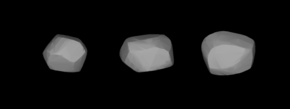258 Tyche is a relatively large main belt asteroid discovered by Robert Luther at Düsseldorf-Bilk Observatory on 4 May 1886. The stony S-type asteroid measures about 65 kilometers in diameter and has a perihelion of 2.1 AU.
Tyche orbits very close to the Eunomia family of asteroids, and could be a member based on composition. However, it is larger than all family members apart from 15 Eunomia while lying at the very edge of the family group. Hence, there is a good chance that it is an unrelated interloper.
There is some uncertainty regarding Tyche's rotation period. Various authors give values from 9.983 to 10.041 hours.
It was named after Greek goddess of fortune, Tyche, which is also the name of one of the Oceanids. Tyche's Roman equivalent is Fortuna, after which the asteroid 19 Fortuna is named.
References
- ^ "JPL Small-Body Database Browser: 258 Tyche" (2015-09-21 last obs.). Jet Propulsion Laboratory. Retrieved 11 May 2016.
- Noah Webster (1884) A Practical Dictionary of the English Language
- ^ Schmadel, Lutz D. (2003). Dictionary of Minor Planet Names – (258) Tyche. Springer Berlin Heidelberg. p. 38. doi:10.1007/978-3-540-29925-7_259. ISBN 978-3-540-29925-7.
- ^ Supplemental IRAS Minor Planet Survey Archived June 23, 2006, at archive.today
- Krasinsky, G.; Pitjeva, E. V.; Vasilyev, M. V.; Yagudina, E. I. (2002). "Hidden Mass in the Asteroid Belt". Icarus. 158 (1): 98–105. Bibcode:2002Icar..158...98K. doi:10.1006/icar.2002.6837.
- PDS lightcurve data Archived June 14, 2006, at archive.today
- Riccioli, D.; Blanco, C.; Cigna, M. (2001). "Rotational periods of asteroids II". Planetary and Space Science. 49 (7): 657. Bibcode:2001P&SS...49..657R. doi:10.1016/S0032-0633(01)00014-9.
External links
- "258 Tyche". JPL Small-Body Database. Jet Propulsion Laboratory. SPK-ID: 2000258.
- The Asteroid Orbital Elements Database
- Minor Planet Discovery Circumstances
- Asteroid Lightcurve Data File
- Ephemeris
- 258 Tyche at AstDyS-2, Asteroids—Dynamic Site
- 258 Tyche at the JPL Small-Body Database

| Minor planets navigator | |
|---|---|
| Small Solar System bodies | |||||||
|---|---|---|---|---|---|---|---|
| Minor planets |
| ||||||
| Comets | |||||||
| Other | |||||||
